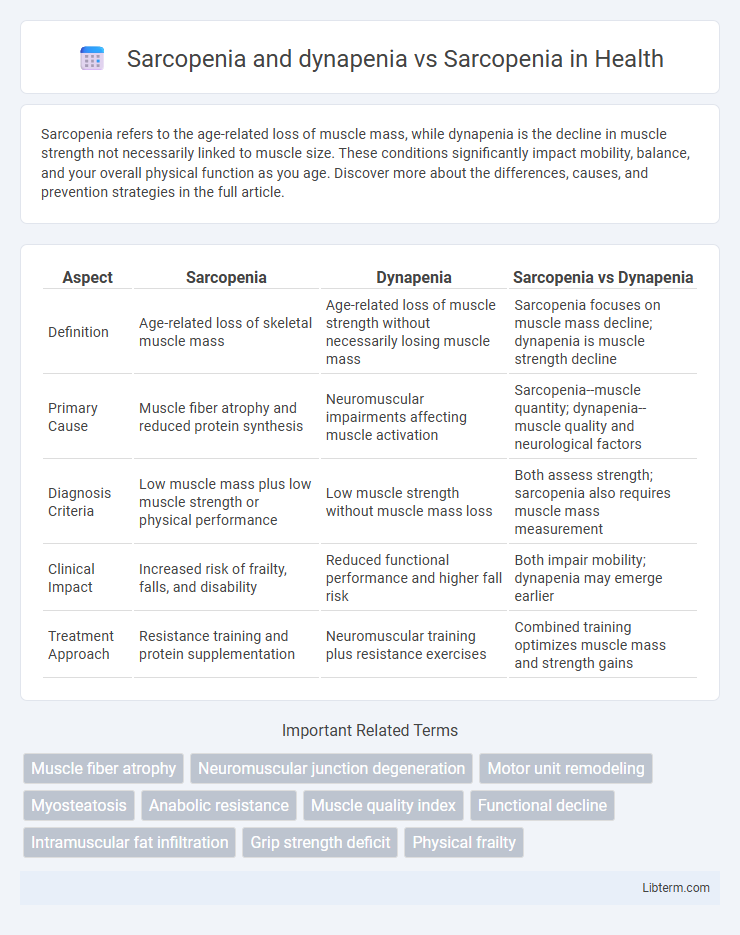Sarcopenia refers to the age-related loss of muscle mass, while dynapenia is the decline in muscle strength not necessarily linked to muscle size. These conditions significantly impact mobility, balance, and your overall physical function as you age. Discover more about the differences, causes, and prevention strategies in the full article.
Table of Comparison
| Aspect | Sarcopenia | Dynapenia | Sarcopenia vs Dynapenia |
|---|---|---|---|
| Definition | Age-related loss of skeletal muscle mass | Age-related loss of muscle strength without necessarily losing muscle mass | Sarcopenia focuses on muscle mass decline; dynapenia is muscle strength decline |
| Primary Cause | Muscle fiber atrophy and reduced protein synthesis | Neuromuscular impairments affecting muscle activation | Sarcopenia--muscle quantity; dynapenia--muscle quality and neurological factors |
| Diagnosis Criteria | Low muscle mass plus low muscle strength or physical performance | Low muscle strength without muscle mass loss | Both assess strength; sarcopenia also requires muscle mass measurement |
| Clinical Impact | Increased risk of frailty, falls, and disability | Reduced functional performance and higher fall risk | Both impair mobility; dynapenia may emerge earlier |
| Treatment Approach | Resistance training and protein supplementation | Neuromuscular training plus resistance exercises | Combined training optimizes muscle mass and strength gains |
Understanding Sarcopenia: Definition and Causes
Sarcopenia is a progressive loss of skeletal muscle mass and strength, primarily caused by aging, hormonal changes, and chronic diseases. Dynapenia specifically refers to the decline in muscle strength without necessarily losing muscle mass, highlighting functional impairment as a key factor. Understanding these distinctions improves diagnosis and treatment strategies targeting muscle function and body composition in elderly populations.
What is Dynapenia? Distinguishing Muscle Strength Loss
Dynapenia refers specifically to the loss of muscle strength that is not solely explained by the loss of muscle mass seen in sarcopenia. Unlike sarcopenia, which emphasizes the decline in muscle quantity and quality, dynapenia highlights the reduction in muscle function and power, often linked to neural and metabolic factors. Distinguishing dynapenia from sarcopenia is crucial in clinical assessment because muscle strength decline predicts adverse health outcomes more accurately than muscle mass loss alone.
Sarcopenia vs. Dynapenia: Key Differences
Sarcopenia primarily involves the loss of skeletal muscle mass and strength due to aging, while dynapenia specifically refers to the decline in muscle strength not solely explained by muscle size reduction. Unlike sarcopenia, which includes quantitative muscle loss measured by imaging techniques such as DXA or MRI, dynapenia highlights functional deficits assessed through grip strength or lower limb power tests. Understanding these distinctions is critical for targeted clinical interventions and optimizing physical rehabilitation in elderly populations.
The Overlap: Sarcopenia and Dynapenia Explained
Sarcopenia refers to the age-related loss of muscle mass, whereas dynapenia specifically denotes the decline in muscle strength not solely explained by reduced muscle size. The overlap occurs as both conditions contribute to impaired physical function and increased risk of disability in older adults, though dynapenia often presents with disproportionate strength loss relative to muscle mass. Understanding this distinction is crucial for designing targeted interventions to improve mobility and reduce fall risk in the elderly population.
Diagnosis Criteria for Sarcopenia and Dynapenia
Diagnosis criteria for sarcopenia primarily involve assessing low muscle mass using imaging techniques like DXA or MRI, combined with tests for reduced muscle strength (e.g., handgrip strength) and physical performance (e.g., gait speed). Dynapenia diagnosis focuses on muscle strength decline without necessarily involving muscle mass reduction, emphasizing strength measures such as handgrip strength or knee extension torque. Differentiating sarcopenia and dynapenia requires integrating these diagnostic parameters to accurately identify muscle quality versus quantity impairments.
Risk Factors Contributing to Muscle Loss and Weakness
Sarcopenia is characterized by the loss of muscle mass, while dynapenia specifically refers to the decline in muscle strength independent of muscle size. Risk factors contributing to both conditions include aging, physical inactivity, poor nutrition, and chronic diseases such as diabetes and cardiovascular disorders. Hormonal changes and inflammation further exacerbate muscle deterioration, increasing the vulnerability to falls, frailty, and reduced functional capacity.
Consequences of Sarcopenia Alone vs. Combined Conditions
Sarcopenia primarily leads to decreased muscle mass, resulting in increased risk of falls, frailty, and impaired physical function. When sarcopenia is combined with dynapenia, which involves loss of muscle strength independent of muscle size, the consequences intensify, causing greater mobility limitations, higher incidence of disability, and increased mortality rates. Understanding the combined impact is critical for developing targeted interventions to improve muscle health and prevent adverse outcomes in aging populations.
Treatment Approaches: Sarcopenia vs. Dynapenia
Treatment approaches for sarcopenia primarily focus on resistance training combined with protein supplementation to increase muscle mass and strength. In contrast, managing dynapenia emphasizes neuromuscular activation exercises and interventions targeting muscle power and neural drive without solely relying on muscle hypertrophy. Both conditions benefit from tailored physical therapy, but dynapenia requires more focus on neural rehabilitation techniques to improve muscle function.
Preventative Strategies for Age-Related Muscle Decline
Preventative strategies for age-related muscle decline focus on resistance training and adequate protein intake to combat sarcopenia and dynapenia, conditions marked by muscular strength and mass loss respectively. Resistance exercises stimulate muscle hypertrophy and neuromuscular improvements crucial for maintaining functional capacity in older adults. Nutritional interventions emphasizing leucine-rich proteins and vitamin D supplementation further support muscle synthesis and mitigate muscle degradation associated with sarcopenia.
Future Research and Trends in Managing Muscle Health
Future research on sarcopenia and dynapenia emphasizes identifying molecular mechanisms distinguishing muscle mass loss from muscle strength decline to develop targeted therapies. Advances in biomarker discovery and imaging technologies aim to enable earlier diagnosis and personalized management strategies. Emerging trends also explore integrative interventions combining resistance training, nutrition, and pharmacological agents to optimize muscle health and functional outcomes in aging populations.
Sarcopenia and dynapenia Infographic

 libterm.com
libterm.com